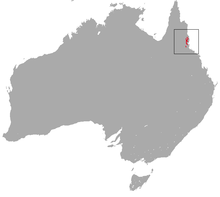Herbert River Ringbeutler
| Herbert River Ringbeutler | ||||||||||||
|---|---|---|---|---|---|---|---|---|---|---|---|---|

The two morphs of the Herbert River Ringbeutler |
||||||||||||
| Systematics | ||||||||||||
|
||||||||||||
| Scientific name | ||||||||||||
| Pseudochirulus herbertensis | ||||||||||||
| ( Collett , 1884) |
The Herbert River Ringbeutler ( Pseudochirulus herbertensis ) is a marsupial from the family of the Ringbeutler , which occurs in the forests of the Atherton Tablelands in northern Queensland between Kuranda and Ingham .
features
Herbert River Ringbeutler have a head-body length of 30 to 40 cm, a tail length of 34 to 47 cm and a weight of 0.75 to 1.5 kg. Due to its high-contrast coloration with a deep brown-black back and a white belly, it can be easily distinguished from any other species of Ringbeutler. There are two morphs , one deep black in which only the belly is white and a second in which the whitish color of the belly extends to the sides of the body and the upper arms. In the latter, the tip of the tail is also white.
Occurrence, habitat and way of life
The Herbert River Ringbeutler occurs in rainforests on basalt soils between 350 and 800 meters above sea level. The animals are nocturnal and spend the day in tree hollows, under epiphytes or, if other options are not available, in self-made nests. They mainly feed on leaves. More than half of the food is eaten at a height of less than 11 meters above the ground, only a quarter at heights of 16 to 20 meters. Herbert River Ringbeutler are loners. The area inhabited by an individual is 0.52 to 3.3 hectares in size. The average population density is one animal on an area of two hectares.
Reproduction
The breeding season lasts for much of the year, from April to December, with most births from May to July. The females have two teats in the bag and get one to two young animals per litter. The young animals are initially hairless, the fur develops around 90 days of age and the young finally leave the pouch between 115 and 120 days of age. They are weaned when they are 150 to 160 days old, and become sexually mature by one year of age.
Danger
The IUCN classifies the Herbert-River Ringbeutler in the “ Least Concern ” category . With an area of less than 5000 km², the range is small, but the animals are quite common, the range is part of the protected Wet Tropics World Heritage Area, there are no major threats to the population and it does not seem to be decreasing. The predators that hunt the Herbert River Ringbeutler include the diamond python ( Morelia spilota ), the Australian amethyst python ( Simalia kinghorni ), the red owl ( Ninox rufa ) and the spotted soot owl ( Tyto multipunctata ).
Individual evidence
- ↑ a b c d e Stephen Jackson: Family Pseudocheiridae (Ring-tailed Possums and Greater Gliders). in Don E. Wilson , Russell A. Mittermeier : Handbook of the Mammals of the World - Volume 5. Monotremes and Marsupials. Lynx Editions, 2015, ISBN 978-84-96553-99-6 , page 524.
- ↑ a b Pseudochirulus herbertensis in the IUCN Red List of Endangered Species .
